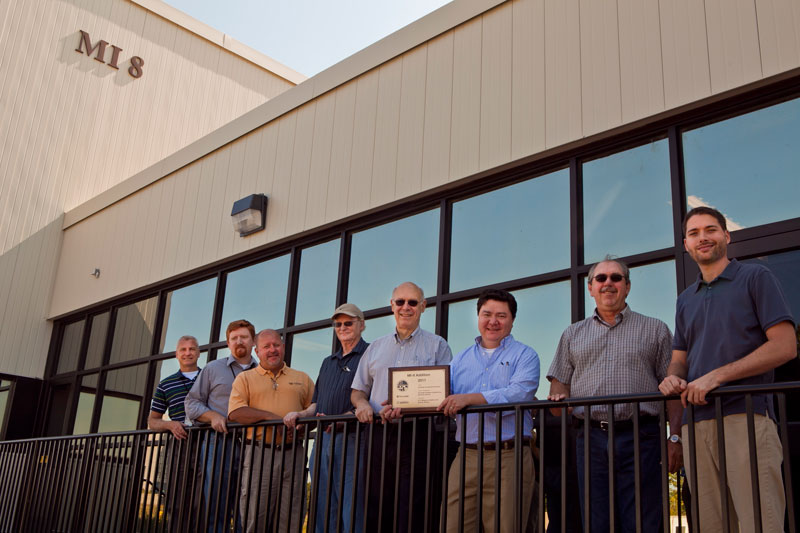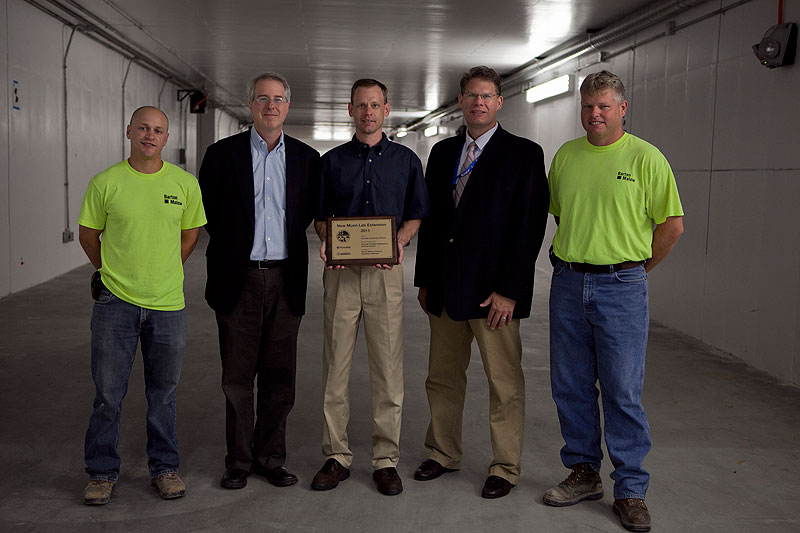Fermilab and the American Recovery and Reinvestment Act
General Infrastructure Projects
High Availability Computing Center

The Computing Division provides administrative, technical and physical support of central computing, storage and networking equipment critical to the success of the labís scientific mission. Before the renovation, Feynman Computing Center housed the only high availability computing center on the Fermilab campus, which operated at its electrical capacity. The requirements for a high availability computing center include backup infrastructure support for computing equipment that operates continuously, such as networking, web and email services, experiment databases and file serving. Electrical service must be backed up by both an uninterrupted power supply system and a standby electrical generator.
This project provided an additional high availability computing center facility within the existing Feynman Computing Center building. It also increased the electrical capacity and associated support functions for the computing center, in order to support high availability computing operations.
On Aug. 16, representatives from the DOE Fermi Site Office, Computing Division, FESS and general contractor Pandecon Inc. celebrated the completion of the FCC cooling upgrade and the high-availability computing center with the dedication of two plaques. These projects were completed with funding from the American Recovery and Reinvestment Act. Photo: Cindy Arnold
Feynman Computing Center Cooling Upgrades

The Feynman Computing Center was constructed in the late-1980ís to provide computing support of high-energy physics programs. With the advent of newer technologies and the lower cost of computers, the physical infrastructure requirements in terms of floor space, power and cooling changed dramatically.
In order to provide reliable, effective cooling to support computing operations within Feynman, the facility required modern data center cooling equipment. This project replaced original water source and chilled water computer room air conditioning units with appropriate state of the art cooling equipment for computing spaces in Feynman.
On Aug. 16, representatives from the DOE Fermi Site Office, Computing Division, FESS and general contractor Pandecon Inc. celebrated the completion of the FCC cooling upgrade and the high-availability computing center with the dedication of two plaques. These projects were completed with funding from the American Recovery and Reinvestment Act. Photo: Cindy Arnold
Industrial Building-3 Addition

This project consisted of a two-story addition to the existing Industrial Building 3 to add 5,800 square feet of office space on the second floor and 7,700 square feet of low-bay laboratory and fabrication space on the first floor. Fermilab now uses the space to consolidate material development, processing and testing, including superconducting materials for magnets and radiofrequency cavities for future accelerators, into one central facility. It also provides office space for scientists, engineers and support staff necessary to accomplish lab goals.
On July 27, representatives from Fermilab's Directorate, the DOE Fermi Site Office, FESS, TD and contractor A.J. Maggio Co. celebrated the completion of the IB3 addition with the dedication of a plaque. The IB3 addition, which will house Fermilab's new materials laboratory, was a project completed with funding from the American Recovery and Reinvestment Act. Photo: Cindy Arnold
Main Injector-8 Service Building Expansion

This project consists of a new high-bay addition to the existing Main Injector-8 Service Building. The MI-8 Service Building was built in 1996 and functions as the access and support building for the Main Injector underground enclosure at the 8 GeV injection point.
The expansion of the MI-8 Service Building was needed to consolidate two Accelerator Division Target Hall Operations Groups into one support facility. Consolidation of both operations groups into the new facility results in added functionality and reduces risk to personnel and equipment as well as provides an overall increase in productivity and quality assurance. Additionally, the consolidation of the two groups in one area facilitates the cross-training of personnel, providing a larger staff for crisis situations.
On Sept. 13, representatives from Fermilab's Directorate, Accelerator Division, FESS and general contractor R.C. Wegman Construction celebrated the completion of the Main Injector-8 Service Building addition with the dedication of a plaque. The addition, which consolidated two Accelerator Division Target Hall Operations Groups into one support facility, was completed with funding from the American Recovery and Reinvestment Act. Photo: Cindy Arnold
New Muon Laboratory Expansion

Superconducting radio frequency technology has many applications for future accelerator projects crucial to Fermilabís future. This project altered the existing New Muon Building to make the facility capable of producing and testing key components for superconducting radio frequency technology.
The project constructed an underground enclosure and support housings for the superconducting radio frequency cryomodules and test beam lines at Fermilab. This enclosure extends beyond the north end of the existing building. Technical beamline equipment occupies the length of the existing facility and the 202-foot extension. The project also included work inside the existing building to relocate the loading dock to accommodate the new tunnel enclosure.
On Aug. 1, representatives from Fermilab's Directorate, the DOE Fermi Site Office, AD and general contractors Barton Malow celebrated the completion of the New Muon Laboratory (NML) expansion project with the dedication of a plaque. The NML expansion, which will house Fermilab's new superconducting radio-frequency test accelerator, was completed with funding from the American Recovery and Reinvestment Act. Photo: Cindy Arnold
Wilson Hall Emergency Generator

The two combustion turbine-generators in the basement of Wilson Hall are the key components in the emergency power system. Given their advanced age, need for ever-increasing maintenance and suspect reliability, they were replaced with a new generator.
The project consisted of locating the new diesel engine-generator at grade adjacent to the existing generator room. Visual screening was installed and adjacent areas landscaped.
The existing generator room will continue to house the automatic switchgear and power panels.
On Aug. 8, representatives from Fermilab's Directorate, the DOE Fermi Site Office, FESS and general contractor Pandecon Inc. celebrated the completion of the generator project in Wilson Hall with the dedication of a plaque. The generator, which will provide electricity to Wilson Hall in the event of a power outage, was completed with funding from the American Recovery and Reinvestment Act. Photo: Cindy Arnold







